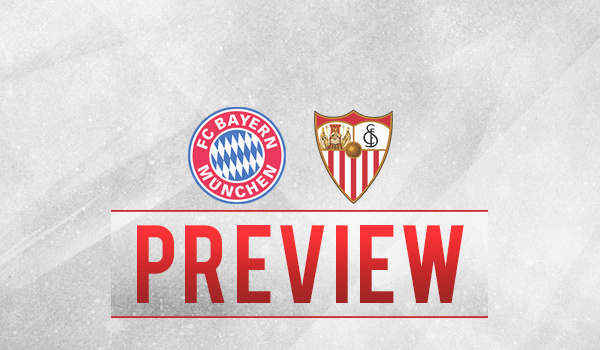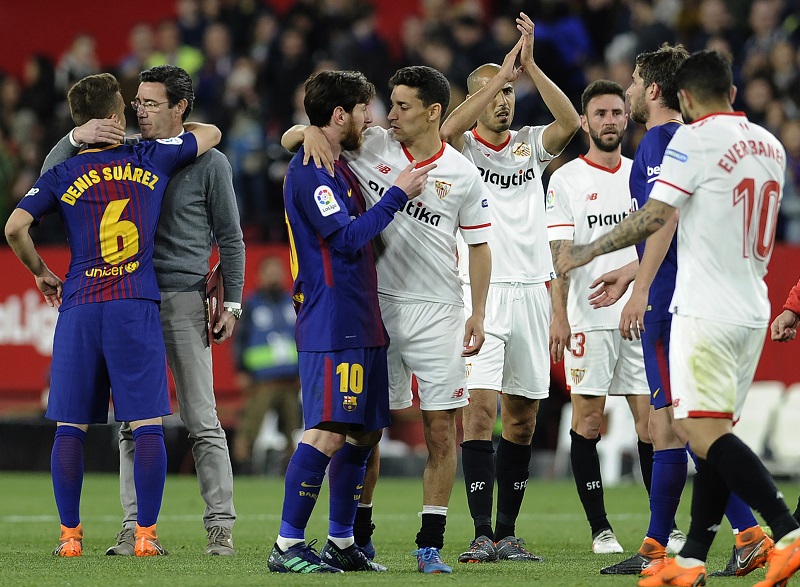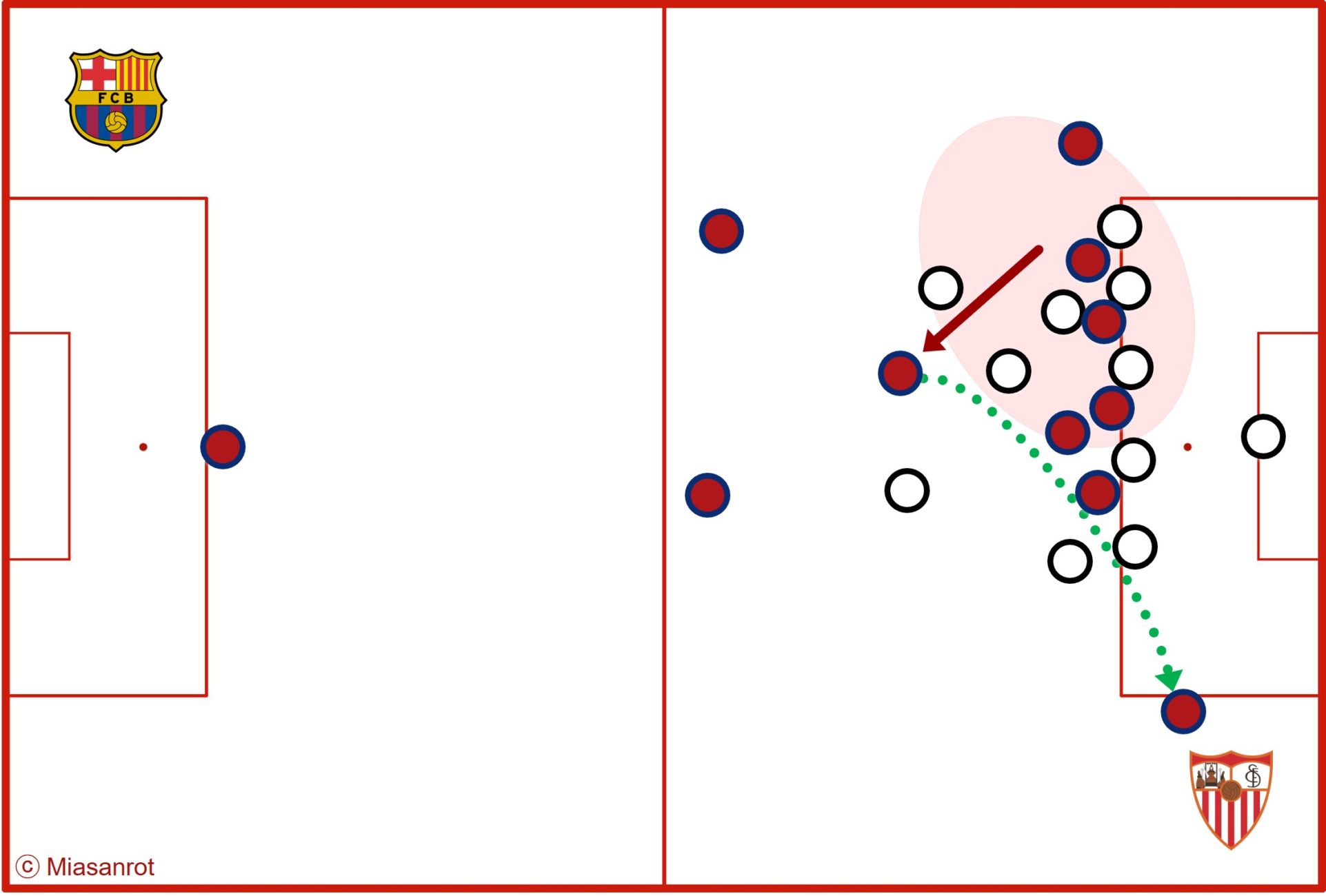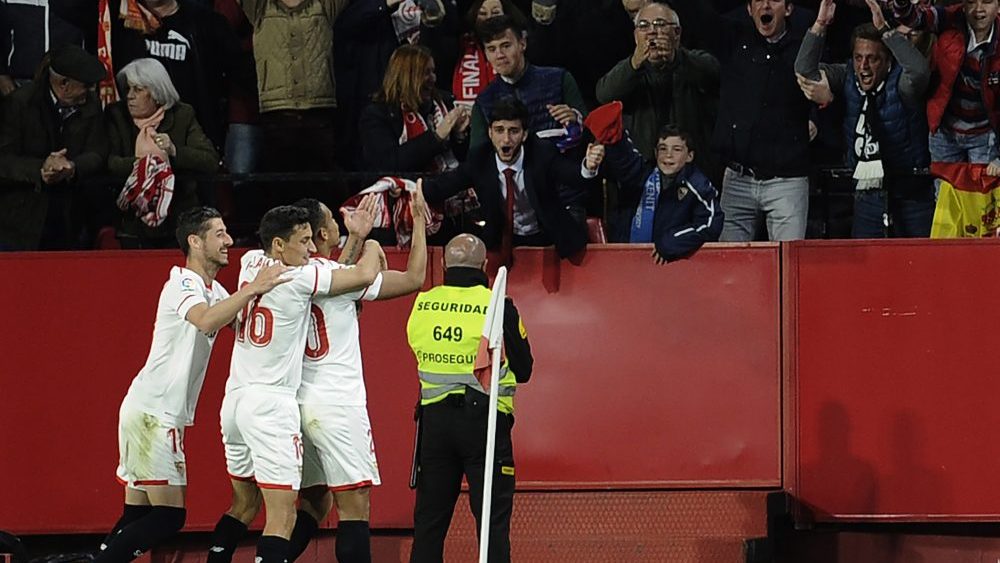Preview: FC Sevilla – FC Bayern
Yes, it could have been much harder for the Münchners. Sevilla is not one of the favourites, and in recent months and years they have even diminished in quality. However, to speak of “luck of the draw” in a quarter-final of the premier class does not do this team justice. Or, as Per Mertesacker puts it: do you seriously think that there is a carnival troupe among the last eight teams in Europe?

Consistent, variable and aggressive pressing
Seville FC won the Europa League three times between 2014 and 2016. At that time, the coach was Unai Emery, who is currently under contract with PSG. Since then Jorge Sampaoli, Eduardo Berizzo and now Vincenzo Montella were employed by the Spaniards. Especially in the league however, the breakthrough above 5th place has never been successful. The team practically lived for the cup competitions. There they were able to play their football most effectively.
Even though Seville are performing inconsistently this season, Bayern must expect an extremely uncomfortable opponent. Especially in the first leg they will face aggressive, well structured pressing. The blueprint for this could be seen on Saturday evening, when Sevilla led for 87 minutes against FC Barcelona 2-0. From the moment the match was underwary,they put the league leaders under pressure time and again.

The basic order is always a 4-4-2 – but in many variations, because Sevilla is especially flexible against the ball. In concrete terms, this means that the Spaniards are only found in their initial formation if they defend a little deeper. The two strikers usually stand a little wider when pressing in the midfield, either to place their opponents in the centre or to support them directly on the outside. Sometimes the two attackers are staggered too. Then a typical 4-2-3-1 formation is formed.

However, especially in the initial phase, Bayern can expect aggressive offensive pressure. Here it is even possible, depending on the situation, that Sevilla works with four players in the first pressing line. The pressure is then maximized in the 4-2-4. In most phases of the game, however, there is a slightly shifted 4-3-3, with the outermost midfielder moving forward near the ball and the remaining three-man chain swiveling. Also a diagonal 4-3-3 could be utilized from time to time, or at least it was against Barcelona, in order to protect the center against passes from the wing-backs.

Sevilla thus consistently manages to direct the opponent’s game structure early on towards the most effective location for intervention. Especially without Busquets, Barcelona lacked the imagination to get between the lines at the weekend. However, Sevilla can also become negligent in shifting and pressing. Until Lionel Messi was introduced, however, the Catalans barely managed to reach the attacking third in a sustainable and dangerous manner. The attacks on the outer track stalled too soon.
When Messi finally entered the pitch, you could see right away how to crack Sevilla. Behind the leading pressing line, they repeatedly offer zones that they cannot defend in excess or equal numbers. Playing the ball there is not so easy. Especially when a player like Messi recognizes these gaps and offers himself to the other player there it is an invitation.

(Foto: Cristina Quicler / AFP / Getty Images)
Sevilla stands for compactness, aggressiveness, intensity and good switching football. Nevertheless, the glamour of the past years has been somewhat diminished. Although they led 2-0 against Barcelona and were well defended, they themselves hardly managed to create danger in switching situations. Mostly the team of Montella only countered over the flank. The lead resulted from a weak defence of Barcelona’s penalty area. Of the 21 total shots the majority felt desperate. Only a few chances emerged from a structured approach, and even fewer shots came from promising positions.
This problem is very noticeable in matches with smaller teams. Against Leganés, Sevilla only managed 10, 3 of them from a good position, all resulting from a cross. With a well structured game and fantastic combination football, the Spanish don’t know exactly how to do it. However, they still somehow manage their chances and almost always score at least one goal. In 2018, Seville remained without goals only against Alavés, Manchester United and Valencia.
Thus Bayern are in a good starting position
A Sevilla goal would not change the fortunes of FC Bayern, but they have to produce high-quality chances against their opponent’s excellent pressing. The Munich players have two aces up their sleeves, which offer an advantage over Barcelona’s initial formation of the weekend, at least against Sevilla: James Rodríguez and Thomas Müller.
Not least because of their excellent form, the Munich team is currently in a position to enter the penalty area in combination. It is the overall position game on the attack that gives hope for two very good games. Bayern is focusing above all on half-space overloading. James and Müller always try to create overloaded situations. Lewandowski also often moves into half or drops into midfield. The five vertical zones are almost always occupied in the offensive area. They can use that to crack Sevilla’s front-most pressing line. If that happens, the Spanish will generally have big problems.
The Munich team has been developing well. They are constantly on the move, but not so much on their toes anymore. Even if Ribéry moves in, triangles form again. The motion sequences are increasingly better coordinated. Months ago this was all rather problematic, but Borussia Dortmund was completely overwhelmed and had no chance this weekend.
The now better positional play also offers Bayern possibilities in counter-pressing. Against Dortmund they won the ball a total of 14 times in the opponent’s half. Even if the currently very passive BVB is no comparison to the aggressive FC Sevilla, the work against the ball will also play an important role there.
Of course, Bayern also occasionally use attacking pressure, but under Heynckes they have also greatly improved their defence from deeper midfield pressure. The Münchners vary their staggering in pressing as well as their height, and are continually improving. Allowing Sevilla to play the ball from time to time, and not allowing them to develop, may make sense from time to time, especially in away matches.
In possession of the ball, the Münchners then need the courage to overload the zones mentioned. James and Müller are the absolute key players at the moment. They should definitely play, but Heyncke’s has other problems.
Especially against a team like Sevilla, it is essential to switch to the defensive if the ball is lost. There, Bayern has been very vulnerable lately. On the one hand, because Javi Martínez often defends a large area alone in front of the defence, and on the other hand, because James and Müller are both not defensive players. Dortmund was thus always in dangerous spaces in the initial phase, but was unable to use them.
Sevilla will use such moments with ice-cold determination. Therefore it would be legitimate for Heynckes to think about two players in the centre who are disciplined and aggressive against the ball. That leaves Thiago and Vidal. Vidal has recently regained some form, however in possession of the ball, he suffers from the disadvantage that the Münchners then too often play on their wings directly. This makes them more predictable.
Thiago, on the other hand, is often underestimated against the ball, but is in fact not only the optimal solution in possession of the ball, but also a major factor for stability. The only thing that would argue against him is that he didn’t have the best rhythm in his last few matches.
Müller could move to the right wing for Robben, who is not yet in shape, whereby his interpretation would then be central as usual. Little would therefore change. Thiago as a bold solution or Vidal as a risky stabilizer? Heynckes will have to make the most interesting decision here.
Ribéry qualified for a starting spot against Dortmund. For the first time in the second half of the season he was able to show a completely error-free performance. Even if the Dortmunders were merely secondary players, they have the courage to do more. With Müller, the focus would be on Kimmich, who could play an important role in Sevilla.
A analysis of events from Barcelona’s guest appearance on Saturday should make it clear how Bayern can be successful against Sevilla: namely through quick relocations and good follow-up actions. Kimmich is perfect for this.

Shortly before halftime it became clear that Sevilla were becoming quite vulnerable. Especially when Barcelona had the ball very far to one side, the defender away from the ball got a lot of space. In the 40th minute, they combined with all their class from a tight situation on the left.
With one pass they opened up to Rakitic, who in turn found Sergi Roberto on the right. Two moves that put an entire team in distress. Because of Roberto’s inaccuracy, the punishment was weak and the goal was blocked at the end. Nevertheless, this was a very informative scene for Bayern.
On the left Alaba, Ribéry, James, Lewandowski and possibly Thiago have all the skills to make the opponent move too strongly. A shift to Kimmich would be sufficient for an enormous gain in space. When Bayern arrive fast and structured enough, Kimmich can play one of his greatest qualities: In entries from the wing.
However, Sevilla also likes to open up spaces diagonally. Kimmich and Müller are intelligent enough to find them, while James, Hummels, Boateng (and Thiago) are good enough to play the necessary passes. Kimmich also occasionally dribbled diagonally against BVB. Sergi Roberto and Dembélé did the same, and Seville had problems with it.
But those are not the only solutions. On Saturday Bayern played repeatedly into the middle, where the team combined to finally get their place in the half spaces and on the outside. There is hardly a better way to fight Sevilla. Bayern have been doing this on a very high level for years, and perhaps this is the biggest weapon for the two matches. Sevilla are missing Banega in the first leg because of a yellow bans. A player who could have brought a lot of dynamism forward, and who also provides some stability. That is why the focus of the Münchners build-up should at first lie in the centre.

Bayern is the favourite, but be careful!
FC Bayern is the clear favourite. That has to be said very clearly. However, the difficult initial phase against Besiktas in the first leg, showed that the allocation of roles can sometimes be clearer than reality.
Sevilla should not be underestimated. Navas, Muriel, Vazquez, Correa, Nolito, Sarabia… The Spanish squad includes not only very fast players, but also technically talented ones. Only if Bayern find the right balance between attacking courage to take risks, good counterattack protection and strong final defence can they claim their role as favorites.
Again, that is all well and good, but not a given. In the first leg, the important foundation stone will be laid. Bayern have often been able to turn around bad first legs at home, but they shouldn’t rely on that this season. Sevilla can also defend well abroad, and their level is higher than that of Porto, Basel or Donezk. A good starting position is therefore indispensable.
Now it counts. If Bayern make it to the semi-finals, they are once again among the best teams in Europe, despite a not unproblematic overall situation. That is the only thing we can claim. That is the only claim of a squad that combines an incomprehensible willpower with great cohesion. A squad that is destined for greatness and still has so much in it.
In Sevilla, Europe must realize that Bayern Munich only wants to win, and above all, can. Anywhere. No matter who they play against. Now is the Champions League. Now is the time to act like champions.









